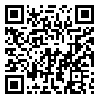

Volume 13, Issue 3 (12-2015)
RBS 2015, 13(3): 367-375 |
Back to browse issues page
Download citation:
BibTeX | RIS | EndNote | Medlars | ProCite | Reference Manager | RefWorks
Send citation to:



BibTeX | RIS | EndNote | Medlars | ProCite | Reference Manager | RefWorks
Send citation to:
فتوت ل, ابوطالبي و, صادقي م, باقريان سرارودي ر. Design and Implementation of an Automatic Bipolar Disorder Detection System Using Brain Signals. RBS 2015; 13 (3) :367-375
URL: http://rbs.mui.ac.ir/article-1-411-en.html
URL: http://rbs.mui.ac.ir/article-1-411-en.html
1- استاديار، گروه مخابرات، دانشکده مهندسي برق و کامپيوتر، دانشگاه يزد، يزد، ايران
2- دانشيار، مرکز تحقيقات علوم رفتاري، گروه روانپزشکي،دانشکده پزشکي، دانشگاه علوم پزشکي اصفهان، اصفهان، ايران
2- دانشيار، مرکز تحقيقات علوم رفتاري، گروه روانپزشکي،دانشکده پزشکي، دانشگاه علوم پزشکي اصفهان، اصفهان، ايران
Abstract: (2685 Views)
Abstract Aim and Background: Correct diagnostic of bipolar disorders by psychologists requires a high level of proficiency and experience. Moreover, in many cases, similar symptoms may lead to misdiagnosis which can worsen the disease. The purpose of this research work is design of an automatic system for effective diagnosis of this disease using brain signals. Such a system can be used as an auxiliary system for the psychologists. Methods and Materials: This study is done on 12 subjects with bipolar disorders and 12 healthy subjects. Signals from sixteen EEG electrodes are recorded according to the standard 10-20 system. Based on the other studies, we use signals from the channels located at F 3 , F 4 , P 3 , P 4 , T 3 , T 4 , O 1 and O 2 area. A set of features including the total signal power, frequency bands power, center frequency, maximum frequency, AR coefficients and Hjorth descriptors are extracted from the signals. The classification task (healthy/bipolar disorders) is then performed using the back propagation and Radial Basis Function (RBF) neural network classifiers. Findings: Our investigations show that among the adopted features, the maximum frequency, theta power, activity and AR coefficients are suitable references for separating the healthy subjects from the diseased ones. Also, the back propagation neural network outperforms the RBF one. Conclusions: In the proposed automatic detection process, the radial basis function neural network classifier leads to a correct diagnosis rate of more than 87%. The back propagation neural network classifier has a correct diagnosis rate of more than 94%. These results confirm that the proposed system can be considered as an auxiliary tool for detecting the bipolar disorders.
| Rights and permissions | |
 |
This work is licensed under a Creative Commons Attribution-NonCommercial 4.0 International License. |



